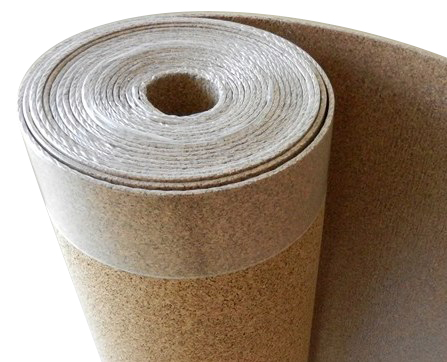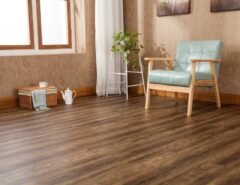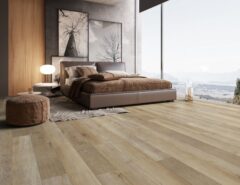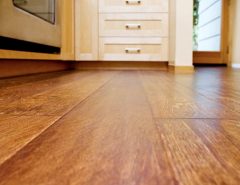
Cork underlay in a roll, this one including a vapor barrier attached. (CorkInsu Cork Underlayment from BuildDirect).
Cork works as an excellent underlayment, the material that goes under your flooring, and provides stability and support. Cork happens to be one of the top choices for underlayment due to its unique structure and incredible benefits for homeowners. Cork is such an exceptional flooring underlayment option because it helps with home acoustics, is comfortable to walk on, it is durable, assists with stress crack prevention, insulates the home, is environmentally sustainable, has health benefits, has various installation methods, and is cost effective.
Acoustics
One of the main factors to consider with any type of flooring is the resulting acoustics in a room. Think of the difference between a carpeted room and a room with a concrete floor; the echoing sounds of concrete aren’t conducive to a warm, welcoming at-home atmosphere. While your choice of flooring plays a big part in room acoustics, the underlayment you select is just as important.
Cork has sound-dampening properties that help reduce the sound of footfalls in rooms and hallways, along with other ambient noise reduction. Installing underlayment that is designed for noise reduction will take away the tension that can be caused by noise levels, which is especially important in condos, apartments, and other multi-family dwellings. Even in single homes, the ability to reduce noise transfer is important for peaceful family living, which is why cork underlayment should be considered as the preferred hardwood and laminate flooring underlayment.
Browse sound-dampening floor underlay.
Comfort
“Made By Nature” brand cork underlay from BuildDirect.
Similar to the above example, it’s easy to picture the difference in comfort between standing on concrete and standing on a plush carpet. The give and cushion provided by a soft surface is easier on your body and provides a better walking experience.
When you choose a hard surface for your flooring, you don’t want that totally flat and solid feel of concrete. That’s where cork comes in — it has a springy structure made from honeycomb-shaped cells that provides cushion as you walk on it. That same structure will help to relieve stress in your feet, legs, and back when standing on a flat, hard surface. By choosing a cork floor underlay, you get the benefits of a softer surface with the sleek look of hardwood or laminate.
Browse underlay that can be used with solid hardwood.
Durability
Despite its springy structure, cork is a dense material. It keeps its shape well over time, which means that it won’t compress easily; it springs back! That’s important in homes, especially in your high traffic areas. You don’t want your floors to sink slightly in these places due to a subpar underlay. By choosing cork underlayment, you’ll help ensure that your floors stay nice and even over time.
Stress Crack Prevention
Having the softer layer between your feet and solid ground not only feels better but it actually protects the floor and its foundation. The cork underlayment creates a barrier that absorbs the impact on the floor, allowing for movement in the floor. This movement allows the floor to expand and contract, preventing stress cracks in the flooring. Stress cracks are common in tile and grout.
Insulation
Choosing laminate or hardwood floors can be a great choice for many reasons, particularly the ease of cleaning and an upgraded home appearance. But one of the downsides to these flooring varieties is that sometimes you lose the cozy warmth of carpet.
Fortunately, a cork floor underlay can help to alleviate this problem. Cork actually acts as natural insulation in the home. That means that it will help keep floors feeling warm under your feet even when you have bare-floor surfaces on top.
Sustainability
Another considerable benefit when choosing cork is its sustainability. Many other underlayment options are synthetic materials, while cork is a natural product that comes from a renewable source. The underlayment material is actually produced from the bark of cork trees as opposed to the tree’s heartwood or sapwood. The bark can be harvested without harming the tree and will regrow naturally over time. These trees are widely found in countries like Spain and Portugal, so there’s no shortage of supply when it comes to choosing cork for your underlayment.
Essentially, cork is one of the top “green” options when it comes to flooring products. If you’re concerned about the environmental repercussions of your home-improvement efforts, opting for a cork underlayment (or full on cork flooring for that matter) is one way to ensure that you’re making the eco-friendly choice.
A harvested cork oak tree. The bark of the tree is harvested every nine years and done so by using hand tools. The result is that the tree remains unharmed, while its bark is then ground up and used to make what we recognize as cork.
Health & Safety
As those who deal with allergies and asthma know, the type of materials used in a home can directly affect residents’ quality of life. For those with these types of sensitivities, cork underlayment is an excellent choice.
Cork has hypoallergenic properties that help to ease the symptoms for people with asthma or allergen sensitivities. The anti-microbial nature of cork inhibits the growth of bacteria, mold, and mildew to create a healthier home environment. Plus, it’s a non-toxic, fire-retardant material that adds a layer of safety to any space where it’s installed.
Installation Options
Yet another benefit of cork as a hardwood, tile, or laminate flooring underlayment is its ease of installation. It has a low height requirement and is generally available in 1/8″, 1/4″ and 1/2″ heights to suit homeowners’ individual needs, keeping in mind that thicker cork typically offers improved sound control. Meanwhile, it comes in sheets or rolls and lays flat for easier measuring and cutting.
Perforated cork underlay under a wood floor.
The type of installation method is also variable depending on the homeowner’s preference. Generally, cork can be installed as a floating underlayment that is not adhered to the original subfloors or by gluing the cork in place. The preferred installation method generally depends on which type of flooring you’re putting on top of your underlay. When purchasing the flooring materials, you’ll want to inquire about how to install the cork underlay if you plan to DIY. The following are some of the most common flooring types installed with cork underlays:
- Vinyl tile
- Ceramic tile
- Rubber tile
- Laminate flooring
- Hardwood flooring
- Carpet
Another factor to consider with cork underlayment installation is moisture. While cork is moisture-resistant, it is not moisture-proof. Therefore, a moisture barrier is typically installed with a cork underlayment in damp areas (like basements) or in particularly damp climates.
Cost
Many homeowners initially believe that, with all its benefits, cork must be one of the more expensive flooring underlay options. In fact, it’s among the more affordable options available and, in many cases, it can be installed by the homeowner for added savings. If you do plan to make this a DIY project, however, be sure to learn more about whether cork is a good complement to your chosen flooring surface and what type of installation method is recommended.
Cork underlayment may not be the most exciting of topics, but choosing it can have a number of positive effects in your household, including a softer walking surface, quieter spaces, and even healthier air for your family to breathe. Make sure you consider what type of underlayment is right for your needs when installing new flooring in your home.
Browse all underlayment products.
Resources:
http://www.flooring-professionals.com/installing-cork-underlayment/
http://www.uptownfloors.com/preparation/sound-control.htm
http://www.homeflooringpros.com/blog-guides/underlayment-the-definitive-buyers-guide/









 (2 rating, average rating is 4.00/5)
(2 rating, average rating is 4.00/5)








